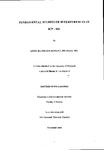FUNDAMENTAL STUDIES OF INTERFERENCES IN ICP - MS
| dc.contributor.author | ROWLEY, LINDA KATHLEEN | |
| dc.contributor.other | School of Geography, Earth and Environmental Sciences | en_US |
| dc.date.accessioned | 2013-09-24T10:23:26Z | |
| dc.date.available | 2013-09-24T10:23:26Z | |
| dc.date.issued | 2000 | |
| dc.identifier | NOT AVAILABLE | en_US |
| dc.identifier.uri | http://hdl.handle.net/10026.1/1918 | |
| dc.description.abstract |
Methods of temperature measurement by mass spectrometry have been critically reviewed. It was concluded that the most appropriate method depended critically on the availability of fundamental data, hence a database of fundamental spectroscopic constants, for diatomic ions which cause interferences in ICP-MS, was compiled. The equilibration temperature, calculated using the different methods and using various diatomic ions as the thermometric probes, was between c.a. 400 - 10,000 K in the central channel, and between c.a. 600 - 16,000 K when the plasma was moved 1.8 mm off-centre. The wide range in temperature reflected the range of temperature measurement methods and uncertainty in the fundamental data. Optical studies using a fibre optic connected to a monochromator were performed in order to investigate the presence of interferences both in the plasma and the interface region of the ICP-MS, and the influence of a shielded torch on these interferences. It was possible to determine the presence of some species in the plasma, such as the strongly bound metal oxides, however, no species other than OH were detected in the interface region of the ICP-MS. The OH rotational temperature within the interface region of the ICP-MS was calculated to be between 2,000 - 4,000 K. The effect of sampling depth, operating power, radial position and solvent loading, with and without the shielded torch, on the dissociation temperature of a variety of polyatomic interferences was investigated. These calculated temperatures were then used to elucidate the site of formation for different polyatomic interferences. Results confirmed that strongly bound ions such as MO+ were formed in the plasma, whereas weakly bound ions such as ArO+ were formed in the interface region due to gross deviation of the calculated temperatures from those expected for a system in thermal equilibrium. | en_US |
| dc.description.sponsorship | VG Elemental, Winsford, Cheshire | en_US |
| dc.language.iso | en | en_US |
| dc.publisher | University of Plymouth | en_US |
| dc.title | FUNDAMENTAL STUDIES OF INTERFERENCES IN ICP - MS | en_US |
| dc.type | Thesis | |
| plymouth.version | Full version | en_US |
| dc.identifier.doi | http://dx.doi.org/10.24382/4432 | |
| dc.identifier.doi | http://dx.doi.org/10.24382/4432 |
Files in this item
This item appears in the following Collection(s)
-
01 Research Theses Main Collection
Research Theses Main


